The Impact of Planting Density and Intermediate Skips on Grain Sorghum Yields
Abstract
1. Introduction
2. Materials and Methods
2.1. Experimental Locations and Conditions
2.2. Experimental Design and Treatments
2.3. Agronomic Management
2.4. Harvesting and Yield Management
2.5. Statistical Analysis
3. Results and Discussion
3.1. Grain Sorghum Yield from Planting Density
3.2. Grain Sorghum Yield from Within Row Spacing
4. Summary
Author Contributions
Funding
Data Availability Statement
Conflicts of Interest
References
- Bandaru, V.; Stewart, B.; Baumhardt, R.; Ambati, S.; Robinson, C.; Schlegel, A. Growing dryland grain sorghum in clumps reduces vegetative growth and increases yield. Agron. J. 2006, 98, 1109–1120. [Google Scholar] [CrossRef]
- Srinivasa-Rao, P.; Belum, V.S.R.; Nagaraj, N.; Hari, D.U. Sorghum production for diversified uses. In Genetics, Genomics, and Breeding of Sorghum; CRC Press: Boca Raton, FL, USA, 2014; pp. 1–27. [Google Scholar]
- Moges, S.M.; Girma, K.; Teal, R.K.; Freeman, K.W.; Zhang, H.; Arnall, D.B.; Raun, W.R. In-season estimation of grain sorghum yield potential using a hand-held optical sensor. Arch. Agron. Soil Sci. 2007, 53, 617–628. [Google Scholar] [CrossRef]
- Ciampitti, I.A.; Prasad, P.V.V.; Schiegel, A.J.; Haag, L.; Schnell, R.W.; Arnall, B.; Lofton, J. Genotype × Environment × Management Interactions: US Sorghum Cropping Systems; In Sorghum: A state of the art and future perspectives; Ciampitti, I.A., Prasad, P.V., Eds.; Agronomy Monographs: Madison, WI, USA, 2019; Volume 1, pp. 273–396. ISBN 9780891186281. [Google Scholar] [CrossRef]
- Quinby, J.R.; Martin, J.H. Sorghum improvement. Adv. Agron. 1954, 6, 305–359. [Google Scholar] [CrossRef]
- FAOSTAT. Food and Agriculture Organization of the United Nations. 2017. Available online: http://www.fao.org/faostat/en/#data/QC (accessed on 19 January 2021).
- Mundia, C.W.; Secchi, S.; Akamani, K.; Wang, G. A regional comparison of factors affecting global sorghum production: The case of North America, Asia, and Africa’s Sahel. Sustainability 2019, 11, 2135. [Google Scholar] [CrossRef]
- Nik, M.M.; Babaeian, M.; Tavassoli, A.; Asgharzade, A. Effect of plant density on yield and yield components of corn hybrids (Zea mays). Sci. Res. Essay 2011, 6, 4821–4825. [Google Scholar] [CrossRef]
- Godsey, C.B.; Linneman, J.; Bellmer, D.; Huhnke, R. Developing row spacing and planting density recommendations for rainfed sweet sorghum production in the southern plains. Agron. J. 2012, 104, 280–286. [Google Scholar] [CrossRef]
- Bond, J.J.; Army, T.J.; Lehman, O.R. Row spacing, plant populations, and moisture supply as factors in dryland grain sorghum production. Agron. J. 1964, 56, 3–6. [Google Scholar] [CrossRef]
- Gerik, T.J.; Neely, C.L. Plant density effects on main culm and tiller development of grain sorghum. Crop Sci. 1987, 27, 1225–1230. [Google Scholar] [CrossRef]
- Kim, H.K.; Luquet, D.; Van Oosterom, E.; Dingkuhn, M.; Hammer, G. Regulation of tillering in sorghum: Genotypic effects. Ann. Bot. 2010, 106, 69–78. [Google Scholar] [CrossRef]
- Nielson, R.L. Stand Establishment Variability in Corn; AGRY-91-1; Purdue University: West Lafayette, IN, USA, 2001. [Google Scholar]
- Liu, W.; Tollenaar, M.; Stewart, G.; Deen, W. Within-row plant spacing variability does not affect corn yield. Agron. J. 2004, 96, 275–280. [Google Scholar] [CrossRef]
- Johnson, R.R.; Mulvaney, D.L. Development of a model for use in maize replants decisions. Agron. J. 1980, 72, 459–464. [Google Scholar] [CrossRef]
- Erbach, D.C.; Wilkins, D.E.; Lovely, W.G. Relationships between furrow opener, corn plant spacing, and yield. Agron. J. 1972, 64, 702–704. [Google Scholar] [CrossRef]
- Oklahoma Cooperative Extension Service CR-2162, Grain sorghum performance trials in Oklahoma. 2017. Available online: https://osucropsdotcom.files.wordpress.com/2018/01/2017-sorghum-performance-trial_final.pdf (accessed on 19 January 2021).
- Berenguer, M.J.; Faci, J.M. Sorghum (Sorghum bicolor L. Moench) yields compensation processes under different plant densities and variable water supplies. Eur. J. Agron. 2001, 15, 43–55. [Google Scholar] [CrossRef]
- Welch, N.H.; Burnett, E.; Eck, H.V. Effect of row spacing, plant population, and nitrogen fertilization on dryland grain sorghum production. Agron. J. 1966, 58, 160–163. [Google Scholar] [CrossRef]
- Staggenborg, S.A.; Fjell, D.L.; Devlin, D.L.; Gordon, W.B.; Marsh, B.H. Grain sorghum response to row spacings and seeding rates in Kansas. J. Prod. Agric. 2013, 12, 390–395. [Google Scholar] [CrossRef]
- Zander, A.; Lofton, J.; Harris, C.; Kezar, S. Grain sorghum production: Influence of planting date, hybrid selection, and insecticide application. Agrosystems Geosci. Environ. 2021, 4, e20162. [Google Scholar] [CrossRef]
- Inuyama, S.; Musick, J.T.; Dusek, D.A. Effect of plant water deficits at various growth stages on growth, grain yield, and leaf water potential of irrigated grain sorghum. Jpn. J. Crop Sci. 1976, 45, 298–307. [Google Scholar] [CrossRef]
- Lewis, R.B.; Hiler, E.A.; Jordan, W.R. Susceptibility of grain sorghum to water deficit at three growth stages. Agron. J. 1974, 66, 589–591. [Google Scholar] [CrossRef]
- Plaut, Z.; Blum, A.; Arnon, I. Effect of soil moisture regime and row spacing on grain sorghum production. Agron. J. 1969, 61, 344–347. [Google Scholar] [CrossRef]
- Musick, J.T.; Dusek, D.A. Grain sorghum response to number, timing, and size of irrigations in the Southern High Plains. Trans. ASAE 1971, 14, 401–0404. [Google Scholar] [CrossRef]
- Liu, X.; Jin, J.; Wang, G.; Herbert, S.J. Soybean yield physiology and development of high-yielding practices in Northeast China. Field Crops Res. 2008, 105, 157–171. [Google Scholar] [CrossRef]
- Nafziger, E.D. Effects of missing and two-plant hills on corn grain yield. J. Prod. Agric. 1996, 9, 238–240. [Google Scholar] [CrossRef]
- Caravetta, G.J.; Cherney, J.H.; Johnson, K.D. Within-row spacing influences on diverse sorghum genotypes: II. dry matter yield and forage quality. Agron. J. 1990, 82, 210–215. [Google Scholar] [CrossRef]
- Jones, O.R.; Johnson, G.L. Row width and plant density effects on Texas High Plains sorghum. J. Prod. Agric. 1991, 4, 613–621. [Google Scholar] [CrossRef]
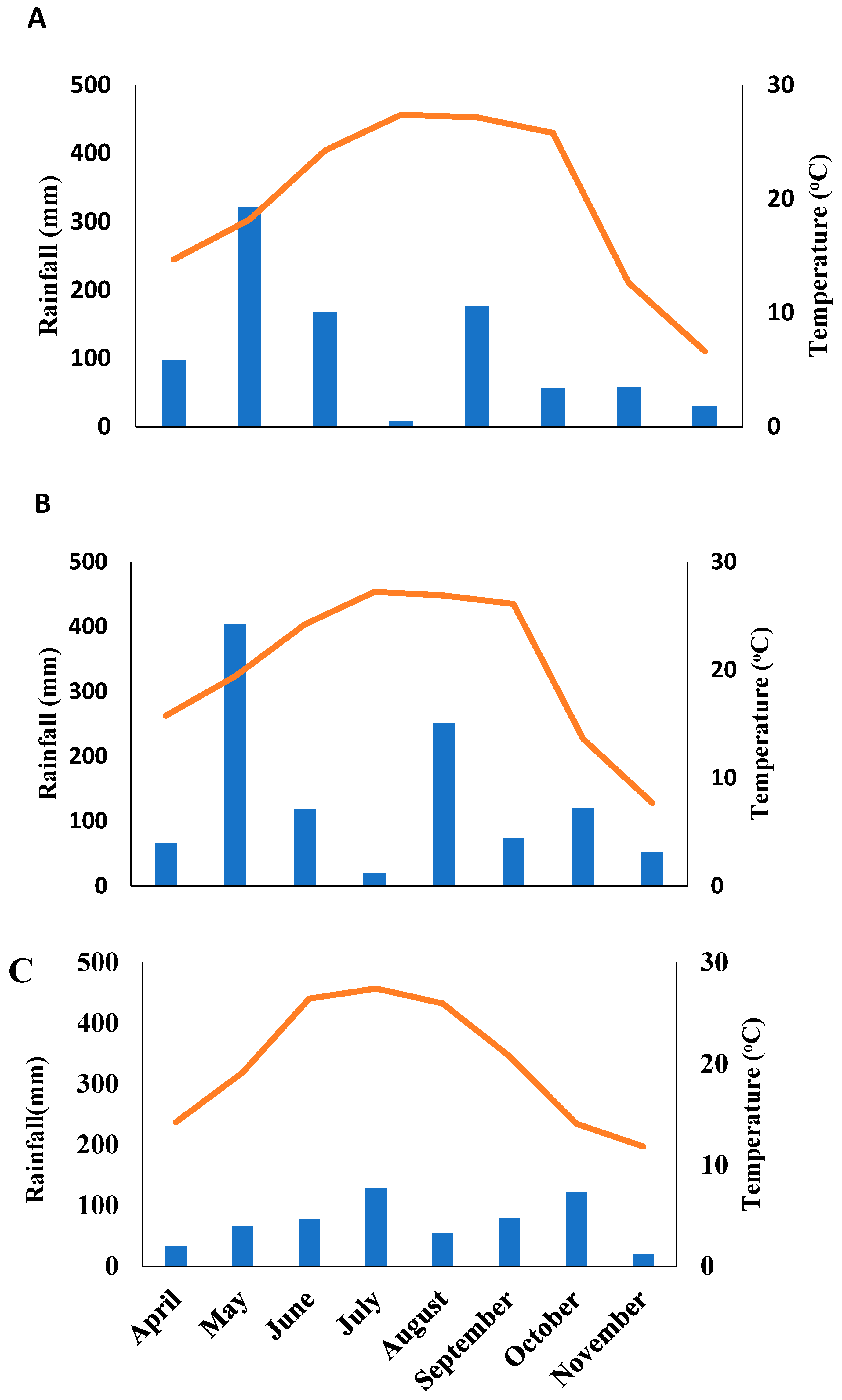
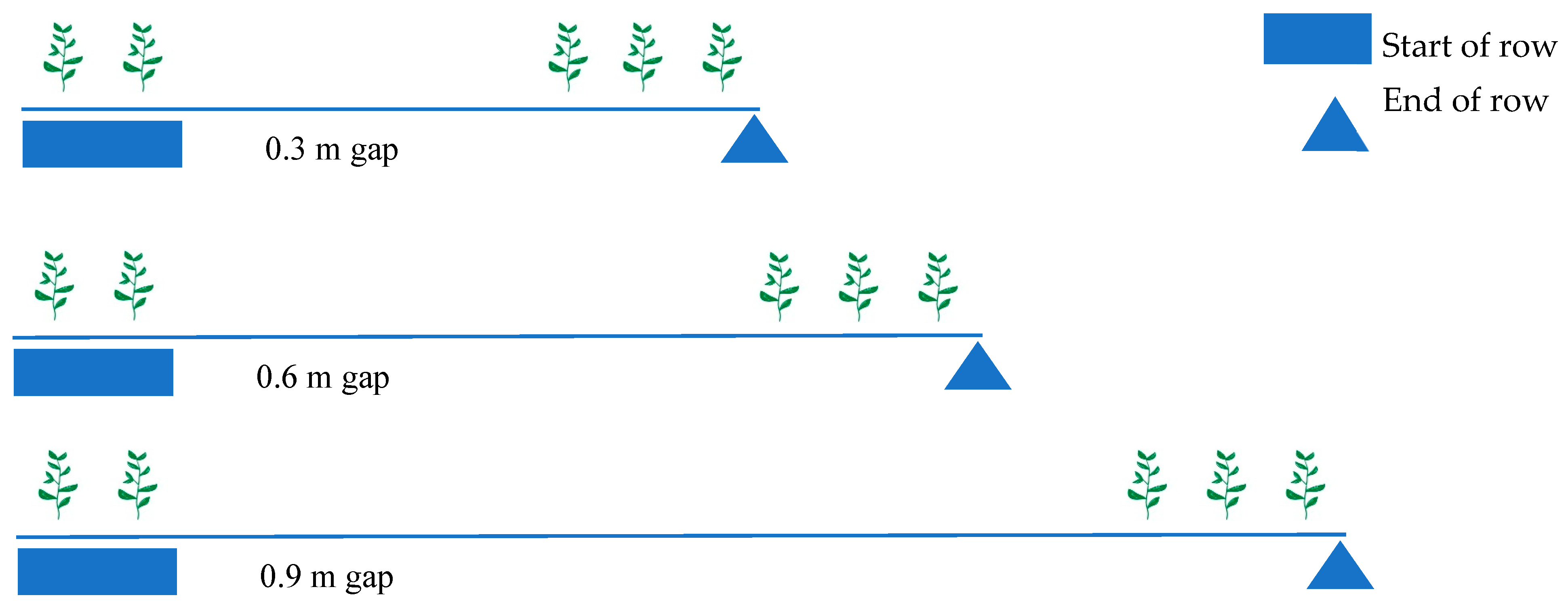
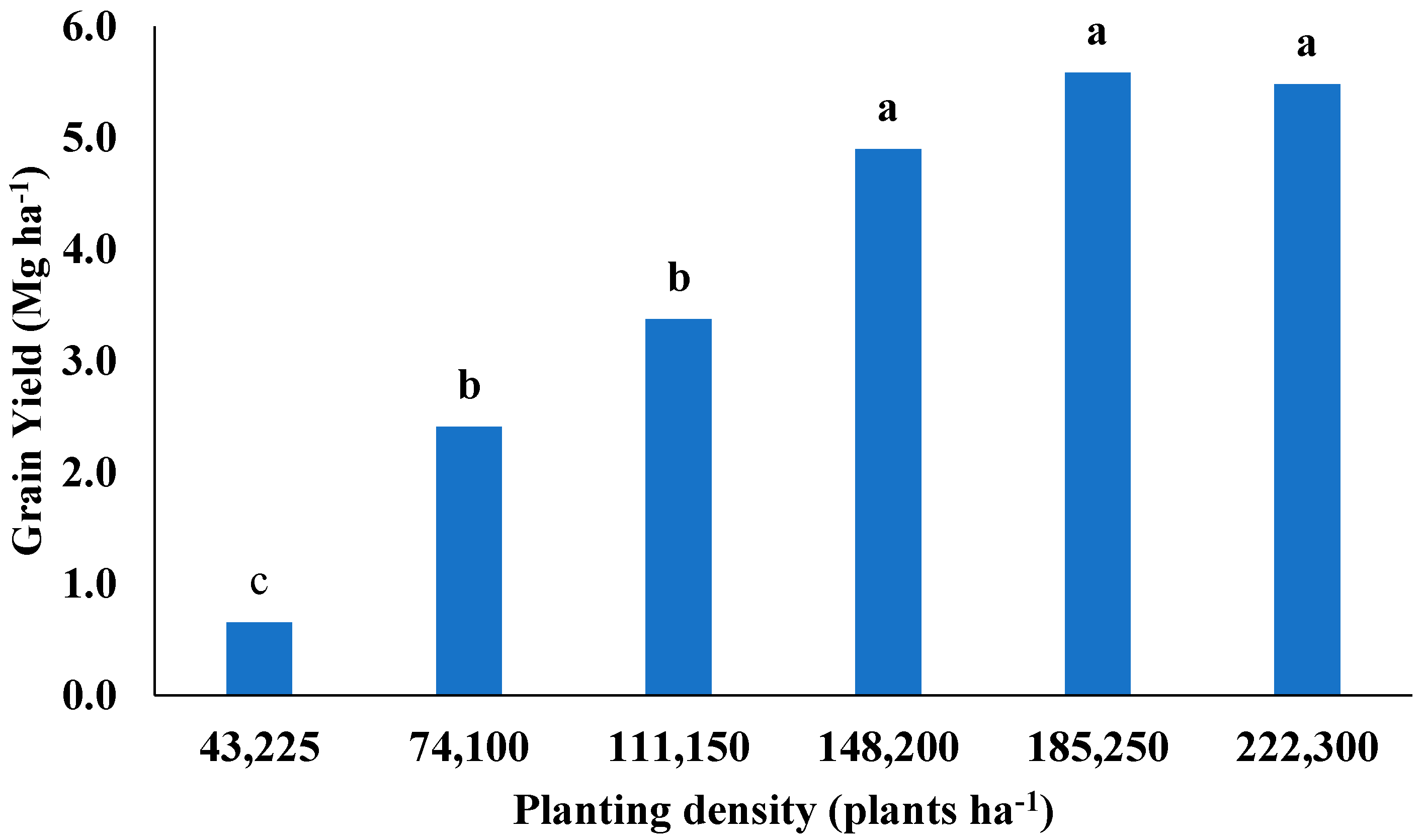
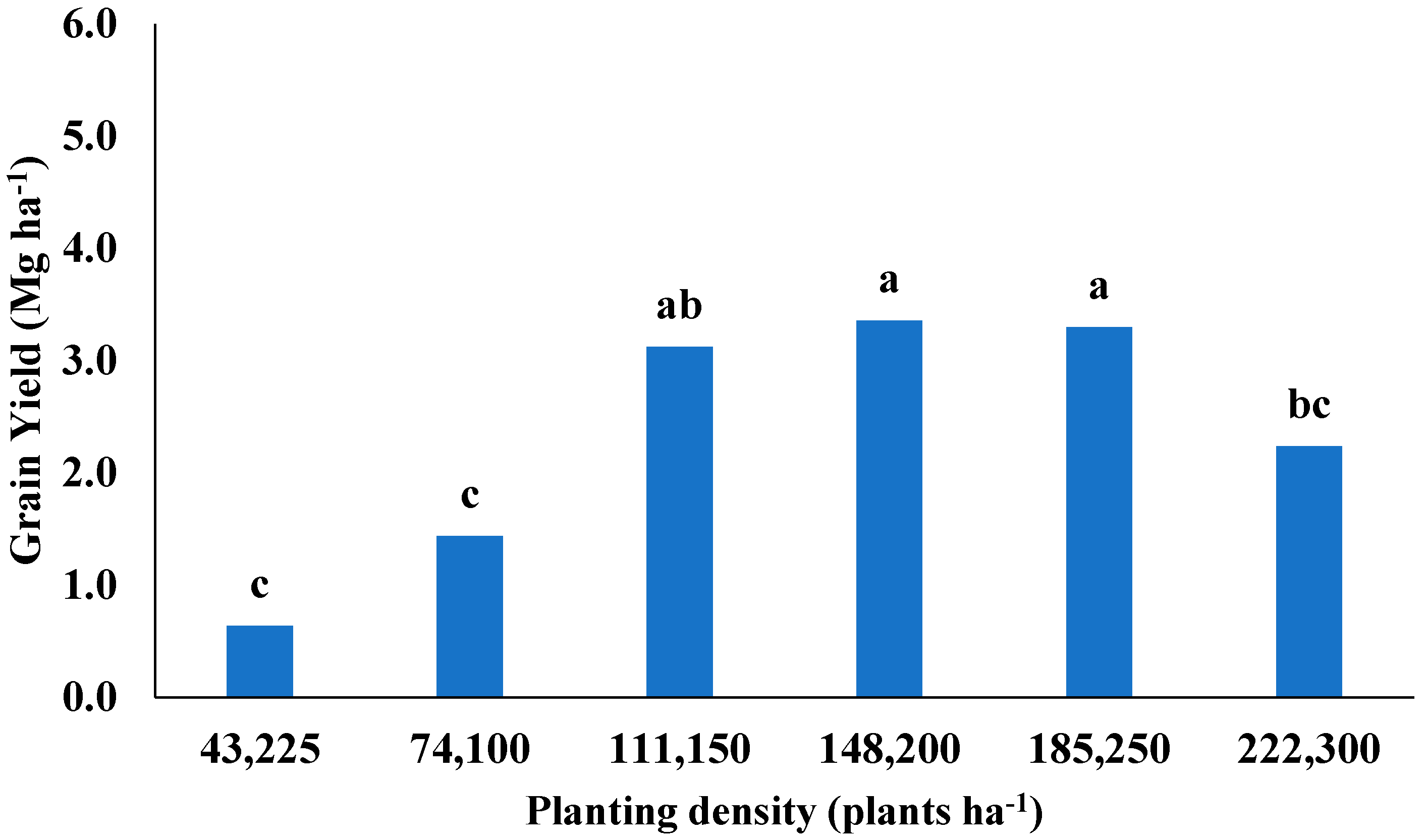
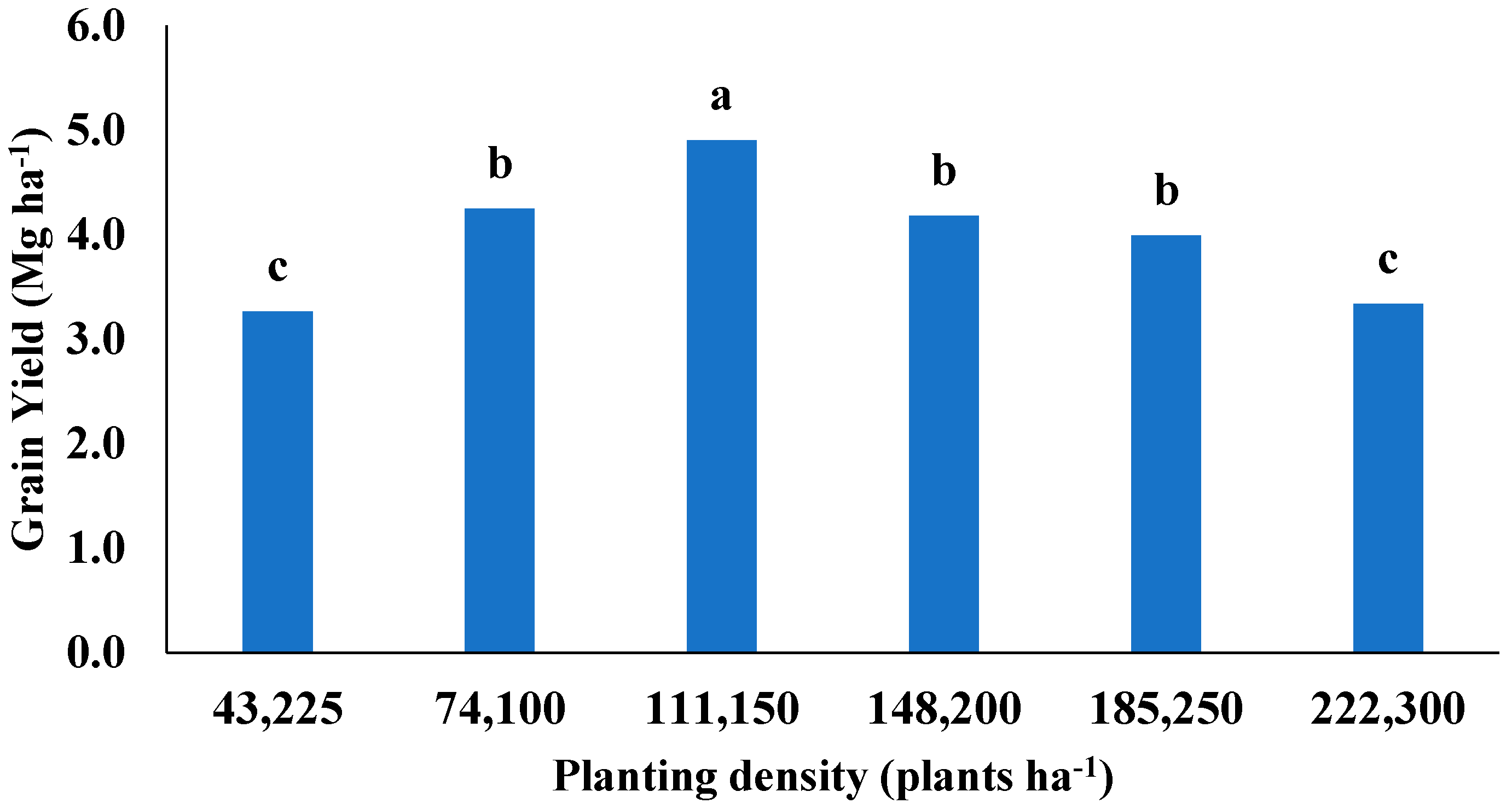
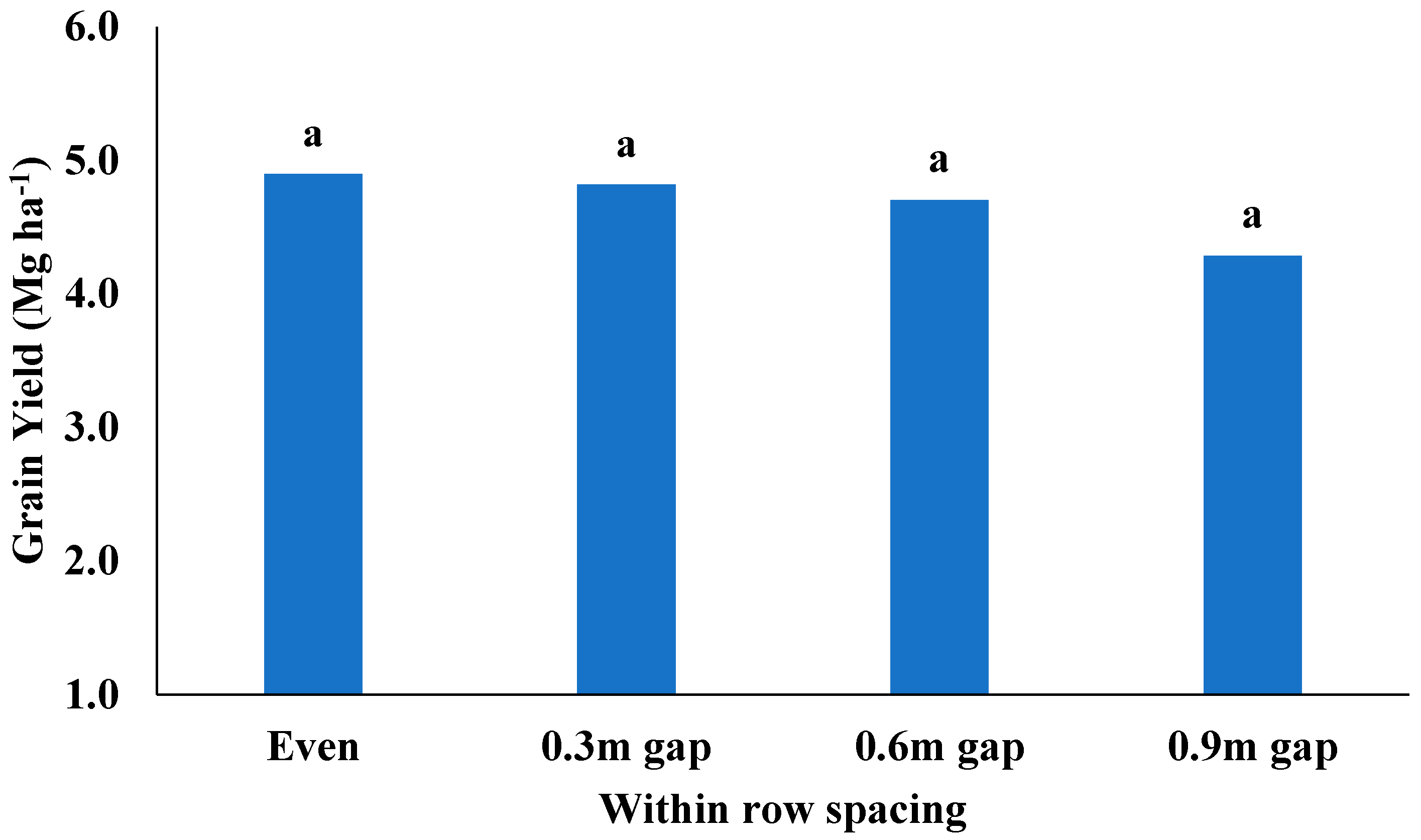
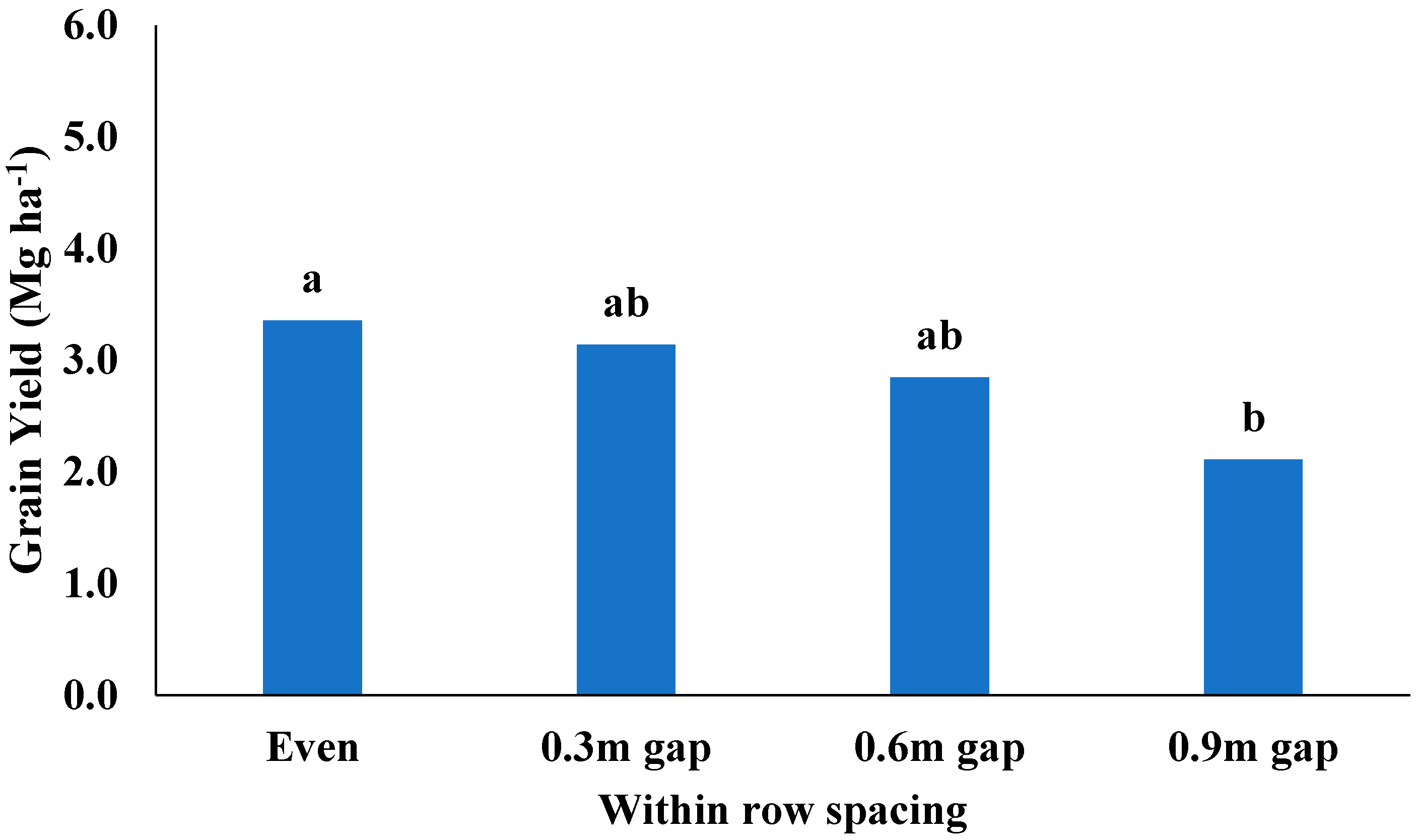
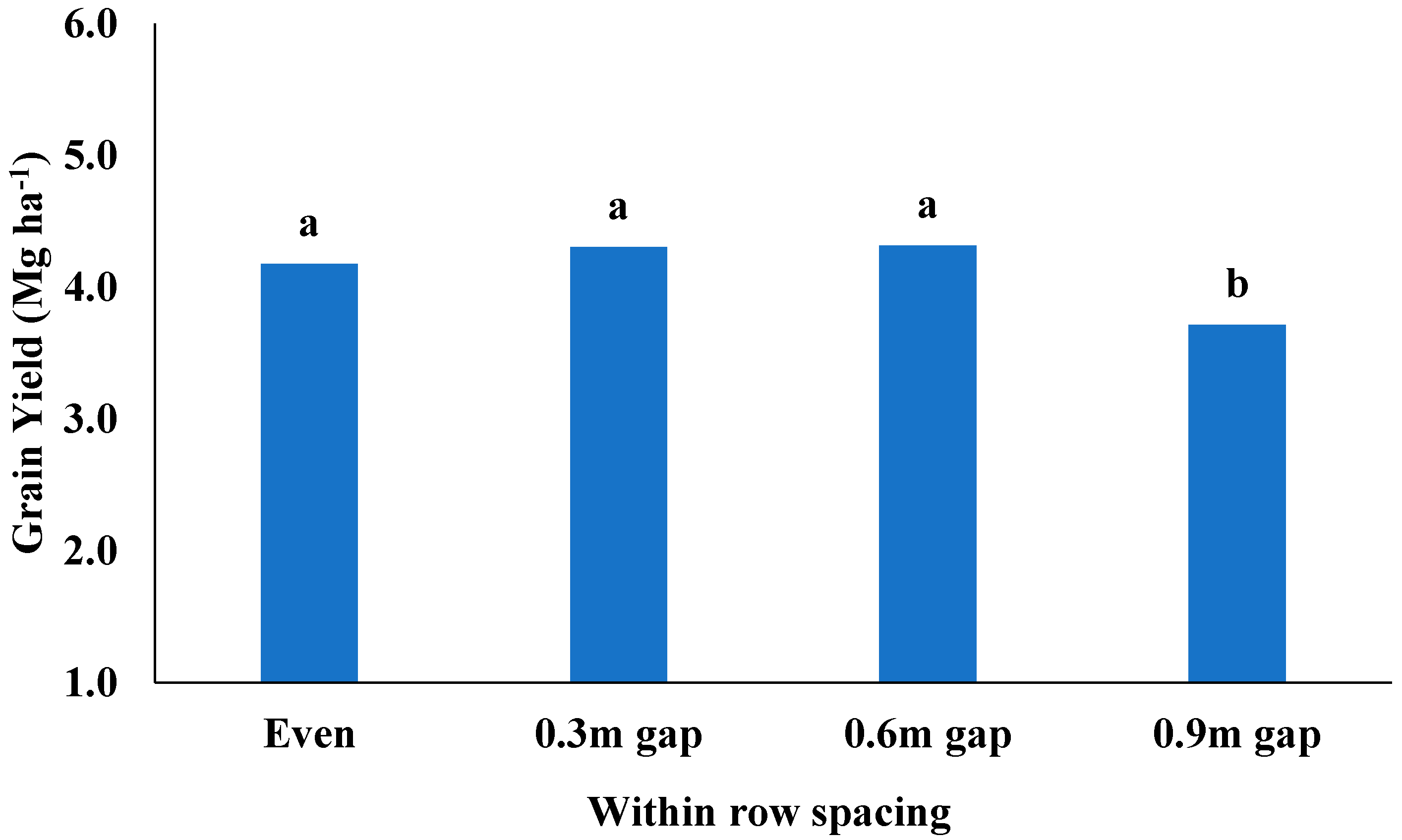
| Location | Soil Classification |
|---|---|
| Perkins | Fine-loamy, mixed, active, thermic Ultic Haplustalf Teller; fine-loamy, mixed, active, thermic Udic Argiustoll |
| Lahoma | Fine silty, mixed, superactive, thermic, Udic Argiustoll |
| Location | Crop Year | Planting Date | Variety | Plant Densities (Plants ha−1) | Harvest Date |
|---|---|---|---|---|---|
| Lahoma | 2019 | 16 April 2019 | SP68M57 | 43,225–223,500 | 11 September 2019 |
| Perkins | 2019 | 14 May 2019 | SP68M57 | 43,225–223,500 | 12 September 2019 |
| 2020 | 20 May 2020 | SP68M57 | 43,225–223,500 | 27 August 2020 |
Disclaimer/Publisher’s Note: The statements, opinions and data contained in all publications are solely those of the individual author(s) and contributor(s) and not of MDPI and/or the editor(s). MDPI and/or the editor(s) disclaim responsibility for any injury to people or property resulting from any ideas, methods, instructions or products referred to in the content. |
© 2025 by the authors. Licensee MDPI, Basel, Switzerland. This article is an open access article distributed under the terms and conditions of the Creative Commons Attribution (CC BY) license (https://creativecommons.org/licenses/by/4.0/).
Share and Cite
Benson, I.; Lofton, J.; Rice, J.; Cannon, B. The Impact of Planting Density and Intermediate Skips on Grain Sorghum Yields. Crops 2025, 5, 25. https://doi.org/10.3390/crops5030025
Benson I, Lofton J, Rice J, Cannon B. The Impact of Planting Density and Intermediate Skips on Grain Sorghum Yields. Crops. 2025; 5(3):25. https://doi.org/10.3390/crops5030025
Chicago/Turabian StyleBenson, Ifekristi, Josh Lofton, Josie Rice, and Brenna Cannon. 2025. "The Impact of Planting Density and Intermediate Skips on Grain Sorghum Yields" Crops 5, no. 3: 25. https://doi.org/10.3390/crops5030025
APA StyleBenson, I., Lofton, J., Rice, J., & Cannon, B. (2025). The Impact of Planting Density and Intermediate Skips on Grain Sorghum Yields. Crops, 5(3), 25. https://doi.org/10.3390/crops5030025





